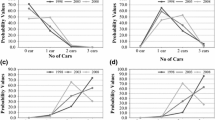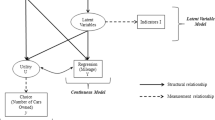Abstract
In this paper a model is formulated to estimate the strength of the relationship between household car ownership and income using cross-sectional data. Whilst reports of such studies are not uncommon in the transport literature, this study is different in that it takes explicit account of the spatial distribution of the data. By incorporating this spatial element in the model formulation, the residual errors in the model are uncorrelated and hence allows for the estimation of parameters that are, in a statistical sense, the best available. These spatial models are fitted to a large data set provided by the United Kingdom Office for National Statistics, covering the area of England and Wales. The recommended model form is a Hierarchical Bayesian spatial regression model with the parameters in the model estimated using the technique of Markov Chain Monte Carlo (MCMC). A common feature of all the spatial models is that the estimate of the elasticity of car ownership with respect to income is seen to be larger than that from a non-spatial model.






Similar content being viewed by others
Notes
Calculated as the gross national disposable income in euro/european currency unit divided by the population and deflated by the index of annual harmonised index of consumer prices (data available from Eurostat 2004).
References
Banerjee, S., Carlin, B. P., & Gelfand, A. E. (2004). Hierarchical modeling and analysis for spatial data. Boca Raton: Chapman and Hall/CRC.
Brunsdon, C, Fotheringham, S., & Charlton, M. (1998). Geographical weighted regression—modelling spatial non-stationarity. The Statistician, 47(3), 431–443.
Carlin, B. P., & Louis, T. A. (2000). Bayes and empirical Bayes methods for data analysis (2nd ed.). Boca Raton: Chapman and Hall/CRC.
Chilés, J. P., & Delfiner, P. (1999). Geostatistics: Modelling spatial uncertainty. New York: Wiley.
Cressie, N. A. C. (1993). Statistics for spatial data (2nd ed.). New York: Wiley.
Dargay, J., & Gately, D. (1999). Income’s effect on car and vehicle ownership, worldwide: 1960 to 2015. Transportation Research Part A, 33(2), 101–138.
Department for Transport (2006). Transport statistics bulletuin: National travel survey: 2006. United Kingdom National Statistics. http://www.dft.gov.uk/162259/162469/221412/221531/223955/322743/NTS2006V3.pdf.
Department for Transport (2008). Vehicle licensing statistics 2007. United Kingdom National Statistics. http://www.dft.gov.uk/adobepdf/162469/221412/221552/228052/367097/vehiclelicensing2007.pdf.
de Jong, G. C. (1997). A micro-economic model of the joint decision on car ownership and car use. In P. Stopher & M. Lee-Gosselin (Eds.), Understanding travel behaviour in an era of change. Oxford: Pergamon.
de Jong, G., Fox, J., Pieters, M., Vonk, L., & Daly, A. (2004). Comparison of car ownership models. Transport Reviews, 24(4), 379–408. See also, Audit of car ownership models. http://www.rand.org/publications/MR/MR1664/.
Economics For The Environment Consultancy Ltd (EFTEC) (2008). Demand for cars and their attributes. Final report, Department for Transport. http://www.dft.gov.uk/pgr/economics/rdg/cardemand/cardemandreport2.pdf.
Eurostat (2004). EC economic data pocket book quarterly (pp. 42–43, 78–19 and 90–91). Luxemburg Office for Official Publications of European Committees. ISSN 1026-0846.
Eurostat (2005). Transport data pocket book. Unit G5 Transport statistics, L-2920 Luxembourg.
Finley, A. O., Banerjee, S., & Carlin, B. P. (2007). spBayes: A program for multivariate point-referenced spatial modeling. Journal of Statistical Software, 19, 4. www.jstatsoft.org.
Gelfand, A. E., Kim, H.-J., Sirmans, C. F., & Banerjee, S. (2003). Spatial modeling with spatially varying coefficient processes. Journal of the American Statistical Association, 98(462), 387–396.
Gelman, A., Carlin, J. B., Stern, H. S., & Rubin, D. B. (2004). Bayesian data analysis (2nd ed.). Boca Raton: Chapman and Hall/CRC.
Giuliano, G., & Dargay, J. (2006). Car ownership, travel and land use: A comparison of the US and Great Britain. Transportation Research Part A, 40(2), 106–124.
Goldring, S., Longhurst, J., & Cruddas, M. (2005). Model-based estimates of income for wards in England and Wales, 2001/02. Technical report, United Kingdom Office for National Statistics.
Golob, T. F., & van Wissen, L. (1989). A joint household travel distanmce generation and car ownership model. Transportation Research Series B, 23(6), 471–491.
Goodwin, P., Dargay, J., & Hanly, M. (2004). Elasticities of road traffic and fuel consumption with respect to price and income: A review. Transport Reviews, 24(3), 275–292. See also, Review of income and price elasticities in the demand for road traffic. http://www.cts.ucl.ac.uk/tsu/elasfinweb.pdf.
Graham, D., & Glaister, S. (2004). Road traffic demand elasticity estimates: A review. Transport Reviews, 24(3), 261–274. See also, Review of income and price elasticities of demand for road traffic. http://www.dft.gov.uk/pgr/economics/rdg/reviewofincomeandpriceelasti3102.
Ingram, G. K., & Liu, Z. (1999). Determinants of motorization and road provision. World Bank Policy Research Working paper 2042.
Komornicki, T. (2003). Factors of development of car ownership in Poland. Transport Reviews, 23(9), 413–439.
Moran, P. A. P. (1950). Notes on the continuous stochastic phenomena. Biometrika, 37, 17–23.
National University of Ireland (2005). GWR software specification. http://www.nuim.ie/ncg/GWR/.
Office for National Statistics (2009). Social trends, issue 39. United Kingdom National Statistics. http://www.statistics.gov.uk/downloads/theme_social/Social_Trends39/Social_Trends_39.pdf.
Pucher, J., & Buehler, R. (2004). Transport policies in Central Europe. New Brunswick: School of Planning and Public Policy, Rutgers University.
R Development Core Team (2005). R: A language and environment for statistical computing. R Foundation for Statistical Computing, Vienna, Austria. ISBN 3-900051-07-0. http://www.R-project.org.
Reuters (2009). European new car sales fall 12.3 percent. http://uk.reuters.com/article/motoringSummary/idUKLNE54D01W20090514.
Robert, C. (2001). The Bayesian choice (2nd ed.). New York: Springer.
Sawada, M. (1999). ROOKCASE: An Excel 97/2000 Visual Basic (VB) add-in for exploring global and local spatial autocorrelation. Bulletin of the Ecological Society of America, 80(4), 231–234.
Social and Spatial Inequalities Research Group (2006). Social and spatial inequalities—tracts information page. Department of Geography, University of Sheffield, Winter Street, SHEFFIELD S10 2TN, UK. http://www.sasi.group.shef.ac.uk/tracts/index.htm.
Spiegelhalter, D. J., Best, N. G., Carlin, B. P., & van der Linde, A. (2002). Bayesian measures of model complexity and fit (with discussion). Journal of the Royal Statistical Society Series B, 64, 583–639.
Tanner, J. C. (1975). Forecasts of vehicles and traffic in Great Britain: 1974 revision. Department of the Environment. Transport Road Research Laboratory Report LR650. Crowthorne: Transport and Road Research Laboratory.
Tanner, J. C. (1978). Long term forecasting of vehicle ownership and road traffic (with discussion). Journal of the Royal Statistical Society Series A, 14, 14–63.
Wheller, D., & Tiefelsdorf, M. (2005). Multicollinearity and correlation among local regression coefficients in geographically weighted regression 2005 (Vol. 7, no. 2, pp. 161–187).
Author information
Authors and Affiliations
Corresponding author
Rights and permissions
About this article
Cite this article
Clark, S., Finley, A.O. Spatial Modelling of Car Ownership Data: A Case Study from the United Kingdom. Appl. Spatial Analysis 3, 45–65 (2010). https://doi.org/10.1007/s12061-009-9030-z
Received:
Accepted:
Published:
Issue Date:
DOI: https://doi.org/10.1007/s12061-009-9030-z




